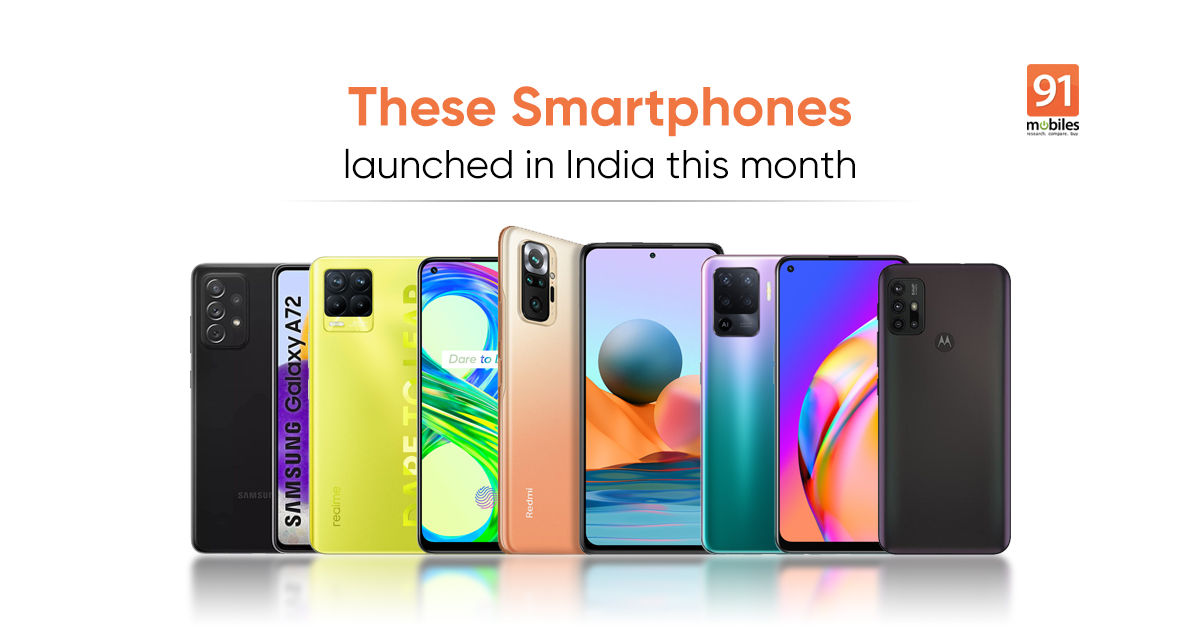
The month was packed to the brim with smartphone launches in India. No wonder they call it March Madness! There was a new smartphone across every price point, from the exorbitantly-priced OnePlus 9 Pro to the entry-level Micromax IN 1. Samsung entered the fray with its mid-range Galaxy A52 and Galaxy A72, as did OPPO with its F19 series. Motorola made an appearance too, with two entry-level SKUs, the Moto G10 Power and Moto G30. However, the real battle was between affordable smartphone giants Xiaomi and Realme, both of who released their highly-anticipated Redmi Note 10 and Realme 8 series of smartphones this month. Let’s take a look at some of the most exciting smartphones that launched in India this month.
Redmi Note 10 Pro Max
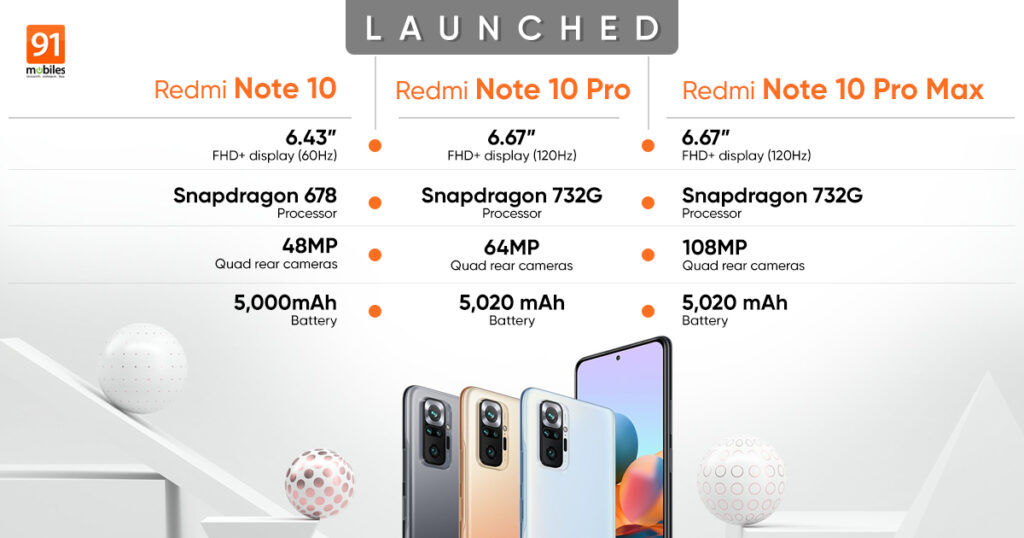
Redmi Note 10 Pro Max is one of the few sub-Rs 20,000 smartphones that comes with a 6.67-inch FHD+ Super AMOLED panel clocked at 120Hz. Other features include 1200nits brightness, HDR 10 support, and TUV Rheinland low blue light certification. It is protected by a layer of Corning Gorilla Glass 5. It is powered by a Snapdragon 732G SoC coupled with up to 8GB RAM and 128GB onboard storage.
At the back, we get a quad-camera array with a 108MP Samsung ISOCELL HM2 primary sensor, a 5MP Super macro sensor, an 8MP ultra-wide-angle lens, and a 2MP depth sensor. A 16MP module takes care of selfies and video calling. Biometric authentication is handled by a side-mounted fingerprint sensor. Lastly, a 5,020mAh battery with 33W fast charging support powers the phone
Redmi Note 10 Pro
The Redmi Note 10 Pro is pretty much a carbon copy of the Redmi Note 10 Pro Max. The only difference between the two devices is the primary camera sensor. It uses a 64MP sensor instead of the 108MP unit on the Pro Max version.
Redmi Note 10
The Redmi Note 10, on the other hand, is remarkably different from its siblings. For starters, it has a smaller 6.43-inch FHD+ AMOLED panel with a standard 60Hz refresh rate, 1100 nits brightness, and Corning Gorilla Glass 3 layer. It is powered by a Snapdragon 678 SoC, along with up to 6GB of RAM and 128GB of storage. Its rear camera array has a 48MP Sony IMX582 primary sensor, an 8MP ultra-wide sensor, and a couple of 2MP snappers for macro and depth shots. A 13MP sensor handles selfies and video calls. Everything else is pretty much the same across all three variants, including its battery, connectivity options, and the likes.
Realme 8 Pro
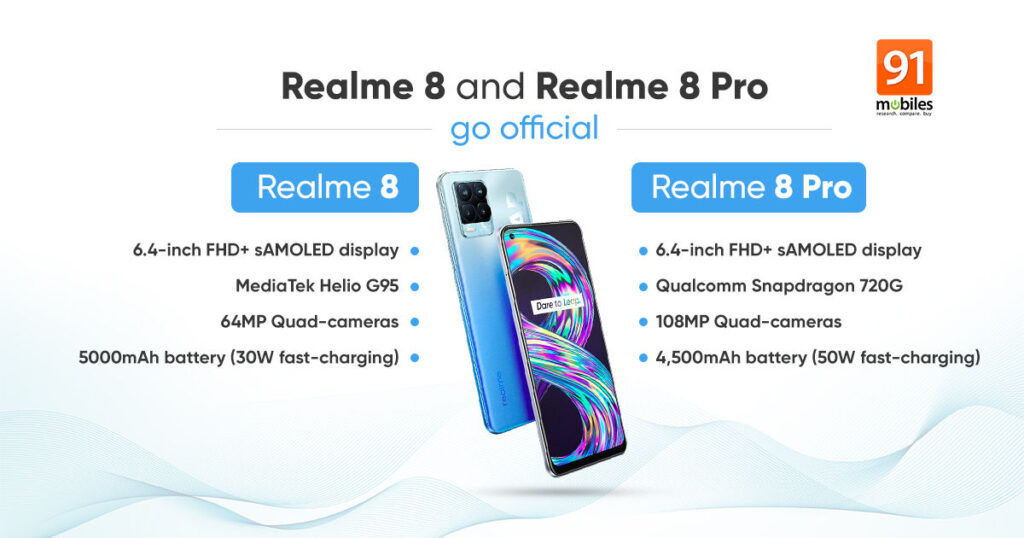
The never-ending battle between Realme and Xiaomi rages on. The Realme 8 Pro features a 6.4-inch FHD+ AMOLED, 180Hz touch-sampling rate, and 1000 nits brightness. A Qualcomm Snapdragon 720G SoC powers it, along with up to 8GB LPDDR4X RAM, and 128GB UFS 2.1 internal storage. Its 4,500mAh battery supports 50W fast-charging support. At the back, we get four camera modules, including a 108MP Samsung HM2 primary sensor, an 8MP ultra-wide-angle lens, a 2MP macro lens, and a 2MP B&W lens. A 16MP Sony IMX471 deals with selfies and video calls.
Realme 8
Realme 8 ships with a 6.4-inch FHD+ AMOLED panel with the same features as the Pro variant. It is powered by the MediaTek Helio G95 SoC, which can be coupled with up to 8GB of RAM and 128GB of storage. It draws power from a 5,000mAh battery with 30W fast-charging support. The Realme 8’s quad-camera array consists of a 64MP primary sensor, an 8MP ultra-wide-angle lens, a 2MP macro lens, and a 2MP B&W lens. Its selfie camera is the same as the Pro variant. Similarly, both the Realme 8 and Realme 8 Pro come with an under-display fingerprint sensor.
OPPO F19 Pro+
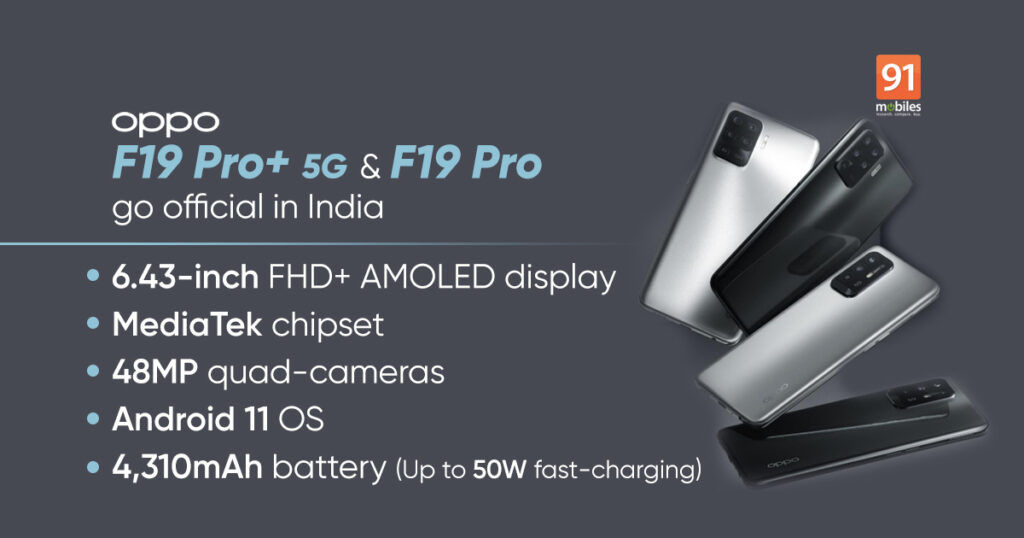
For reasons best known to OPPO, it decided to launch two questionably-priced phones in India, right before Realme and Xiaomi. Both phones, for all intents and purposes, are dead in the water. They might find some success in offline markets, but that’s about it. OPPO F19 Pro+ comes with a 6.4-inch FHD+ AMOLED panel clocked at 60Hz. It is powered by the MediaTek Dimensity 800U 5G coupled with 8GB RAM and 128GB storage that is further expandable via a microSD card up to 256GB.
Its 4,310mAh battery supports 50W VOOC flash charging. For the cameras, we get a 48MP primary sensor, an 8MP ultra-wide-angle-macro lens, a 2MP portrait sensor mono lens, and a 2MP macro mono camera. There is a 16MP sensor on the front for selfies and video chats. OPPO has thrown in an under-display fingerprint sensor, too.
OPPO F19 Pro
The OPPO F19 Pro is essentially the OPPO F19 Pro+ with a MediaTek Helio P95 4G chipset. The previous-generation chipset also causes it to restrict its changing wattage to 30W. The battery capacity remains identical across both models, though.
Moto G30 and Moto G10 Power
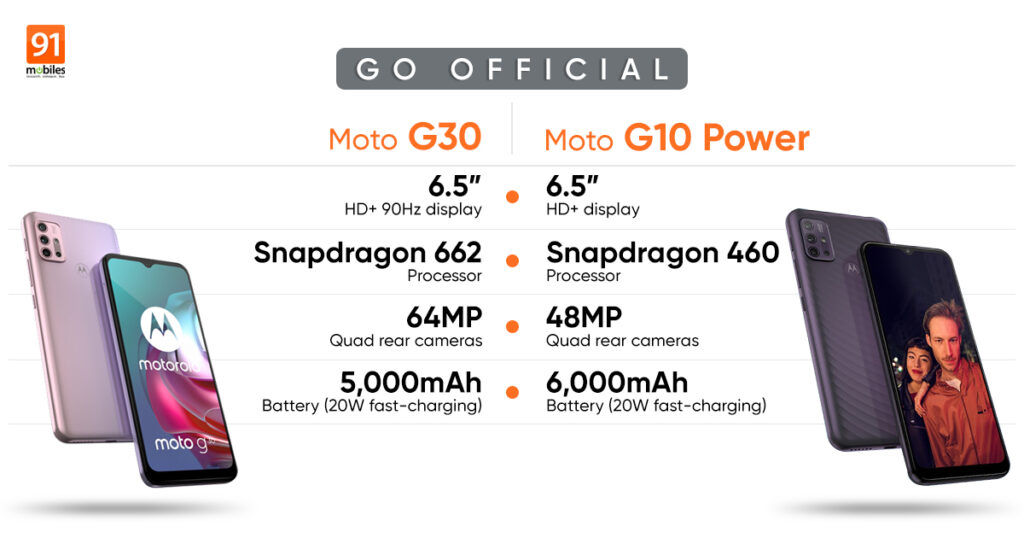
Moto G30 is the newest mid-range offering from Motorola. Like many Motorola phones before it, it runs a Qualcomm Snapdragon 662 chipset, combined with up to 4GB RAM, and 64GB storage. Its 6.5-inch HD+ IPS LCD panel has a refresh rate of 90Hz, somewhat of a rarity in this segment. Unlike many of its competitors, the Moto G30’s 5,000mAh battery supports fast charging at 20W. Its quad-camera array consists of a 64MP primary sensor, an 8MP ultra-wide-angle lens, a 2MP depth sensor, and a 2MP macro lens. It also has a 13MP at the front. Biometric authentication is handled by a rear-mounted capacitive fingerprint scanner.
Moto G10 Power
The Moto G10 Power is a somewhat watered-down version of the Moto G30. It has a much larger 6,000mAh battery, though, which also supports 20W fast charging. Under the hood, there is a Qualcomm Snapdragon 460 SoC coupled with 4GB RAM and 64GB storage. It has four camera sensors at the back, a 48MP primary lens, 8MP ultra-wide-angle lens, and the two 2MP sensors found on the Moto G30. Its selfie camera module is 8MP. A rear-mounted fingerprint sensor is also included.
Micromax IN 1
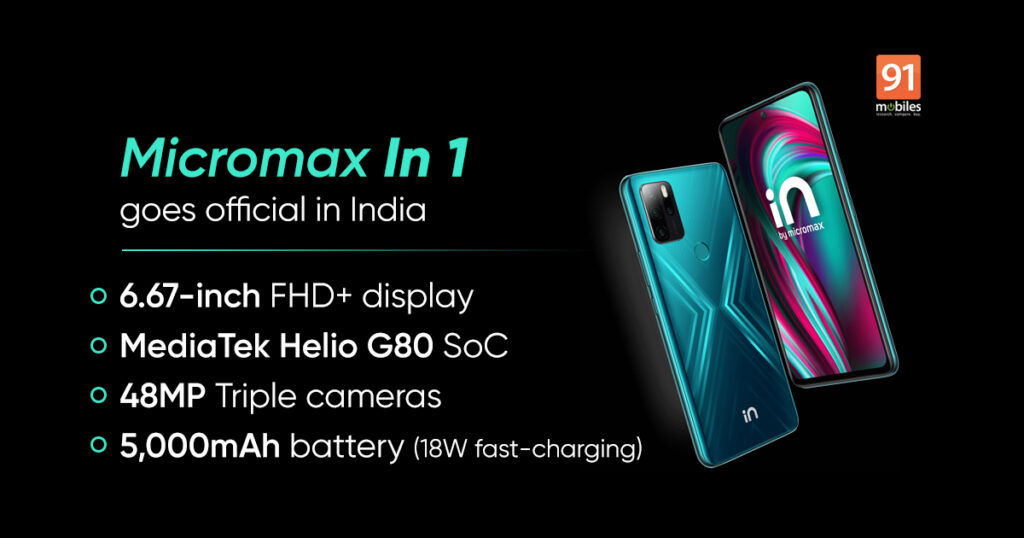
Not wanting to miss out on the March madness, Indian upstart Micromax also decided to join the fray with its new Micromax IN 1 priced starting from Rs 9,999. The phone features a 6.67-inch FHD+ LCD, MediaTek Helio G80 SoC, 4GB RAM, and 64GB storage under the hood. Biometric authentication is handled by a rear-mounted fingerprint sensor. At the back, we get three camera lenses a 48MP primary sensor, a 2MP wide-angle lens, and a 2MP depth sensor, rounded off by an 8MP module for narcissism. Lastly, the smartphone is powered by a 5,000mAh battery with 18W fast-charging support.
Samsung Galaxy A72, Galaxy A52, and Galaxy M12
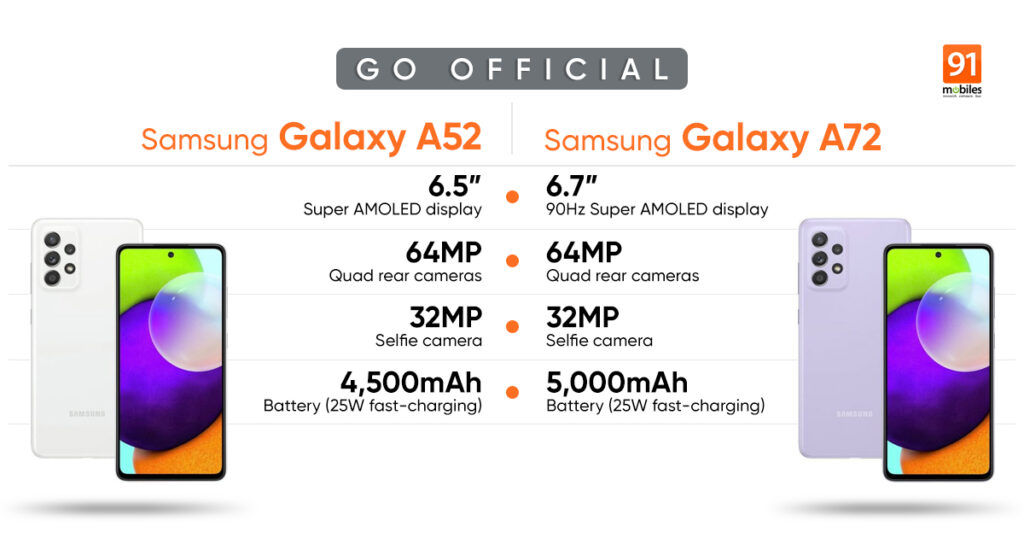
The Samsung Galaxy A72 and Samsung Galaxy A52 were teased a lot before launch. The top-of-the-line Samsung Galaxy A72 sports a 6.7-inch FHD+ Super AMOLED with 800 nits of peak brightness and a 90Hz refresh rate. It is powered by a mystery octa-core processor, likely a Qualcomm Snapdragon 720G, paired with up to 8GB RAM and 256GB internal storage. A 5,000mAh battery with 25W charging support powers the smartphone. The Samsung Galaxy A72 features a quad-camera setup at the back with a 64MP primary sensor, a 12MP ultra-wide-angle lens, an 8MP telephoto lens, and a 5MP macro sensor. On the front, it has a 32MP snapper for selfies and video chats. It is one of the handful of mid-rangers that come with a decent telephoto lens.
Samsung Galaxy A52
As its name suggests, the Samsung Galaxy A52 is a downgraded Galaxy A72, with a 6.5-inch FHD+ Super AMOLEDclocked at 90Hz and 800 nits brightness. It probably uses the same chipset as the Galaxy A72, coupled with 8GB RAM and 256GB internal storage. At the back, we get our tried and tested ques camera array with a 64MP primary sensor, a 12MP ultra-wide-angle lens, a 5MP macro lens, and a 5MP depth sensor. On the front, it has a 32MP module for Instagram and all that. The smartphone’s 4,500mAh battery supports 25W fast-charging.
Samsung Galaxy M12
Although its launch was largely overshadowed by the other high-profile devices, the Samsung Galaxy M12 is a surprisingly well-specced mid-ranger. Its 6.5-inch HD+ has a refresh rate of 90Hz, on par with the similarly-priced alternative from Motorola. An Exynos 850 SoC paired with up to 6GB RAM and 128GB of storage powers the smartphone. Similarly, a 6,000mAh with a 15W support power the phone over a Type-C port.
At the back, there lies a 48MP ISOCELL GM2 primary sensor, a 5MP ultra-wide sensor, and a couple of 2MP snappers for depth and macro shots. An 8MP selfie camera handles the rest. There is even a side-mounted fingerprint scanner for biometric authentication.
Vivo X60
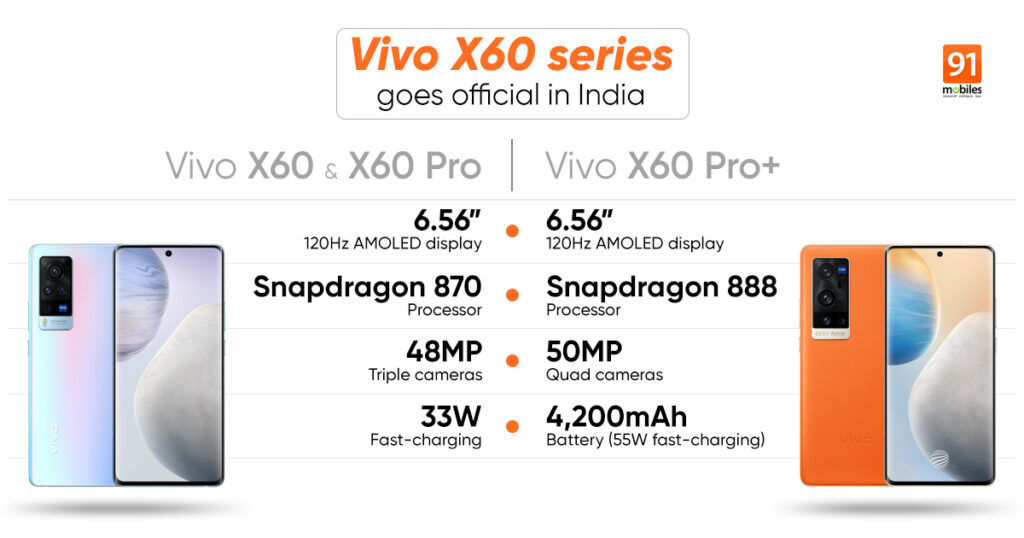
Vivo launched its X60 series of smartphones globally right around the same time as OnePlus. They are a force to be reckoned with, especially when it comes to camera prowess. The base Vivo comes with a 6.56-inch FHD+ AMOLED screen with a 120Hz refresh rate, HDR10+, and Corning Gorilla Glass 6. Interestingly enough, the global Vivo X60 will use a Snapdragon 870 coupled with up to 8GB of RAM and 256GB of storage. Unfortunately, there is no option for micro SD expansion. At the back, we get three cameras – a 48MP primary, a 13MP ultrawide, and a 13MP telephoto. A 32MP camera takes care of selfies and video calls. The smartphone draws power from a 4,300mAh battery with 33W fast charging. Other Vivo X60 features include an in-display fingerprint scanner, 5G connectivity, Wi-Fi 6, Bluetooth 5.1, NFC, and more
Vivo X60 Pro
The Vivo X60 Pro is essentially a souped-up Vivo X60 with 12GB of RAM and 256GB of storage. Its 48MP camera sensor gets gimble stabilization but the remaining camera setup is identical to that of the Vivo X60. The same 32MP selfie camera module used across all three devices. Lastly, the smartphone draws power from a 4,200mAh battery with 33W charging.
Vivo X60 Pro+
Moving on to the top-of-the-line Vivo X60 Pro+, we get Qualcomm’s best and latest Snapdragon 888 chipset. Everything else, including the display specifications and battery, are the same across all three variants. However, the Vivo X60 Pro+ has packed some serious hardware for its rear camera setup, which consists of a 50MP primary camera, 48MP ultra-wide-angle lens, 32MP telephoto lens with 2x optical zoom, and an 8MP periscope lens with 5x optical zoom at the rear.
ASUS ROG Phone 5
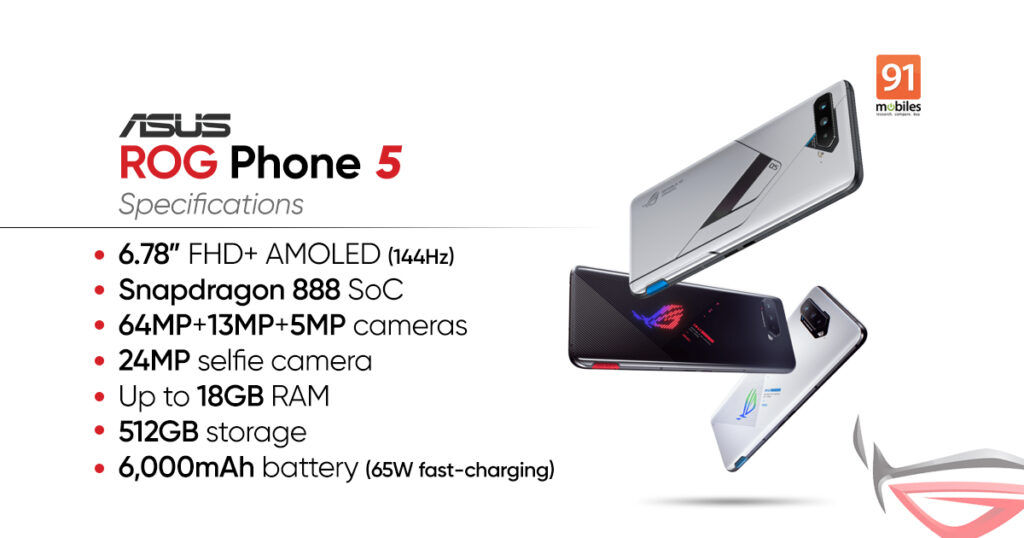
Moving on to some of the more high-profile releases, ASUS launched its newest line of gaming smartphones in March. The ASUS ROG Phone 5 sports a 6.78-inch FHD+ AMOLED panel with a 144Hz refresh rate, 300Hz touch sampling rate, HDR10+ support, and Pixelworks i6 MEMC chip. It is protected by a layer of 2.5D Corning Gorilla Glass Victus. Under the hood, we get a Snapdragon 888 chipset coupled with up to12GB LPDDR5 RAM and up to 256GB UFS 3.1 storage. Its 6,000mAh battery comes in a dual-cell configuration and supports 65W fast-charging.
Gaming smartphones aren’t really renowned for their cameras, but the ASUS ROG PHone 5 packs an impressive 64MP Sony IMX686 sensor, a 13MP ultra-wide-angle sensor, and a 5MP macro sensor at the back. There is a 24MP snapper on the front for selfies and video calling and an in-display fingerprint sensor for security. Further accentuating its gamer aesthetic is its ROG logo at the back, which can be configured via software.
ASUS ROG Phone 5 Pro and ROG Phone 5 Ultimate Edition
Both SKUs are mostly identical to the base ROG Phone variant. However, the ASUS ROG Phone 5 Pro can be configured with up to 512GB of storage and 16GB of RAM. The ASUS ROG Phone 5 Ultimate bumps it up to 18GB of RAM, the highest-ever in any smartphone. Furthermore, both phones come with extra adaptive triggers and a configurable POLED display at the back.
OnePlus 9
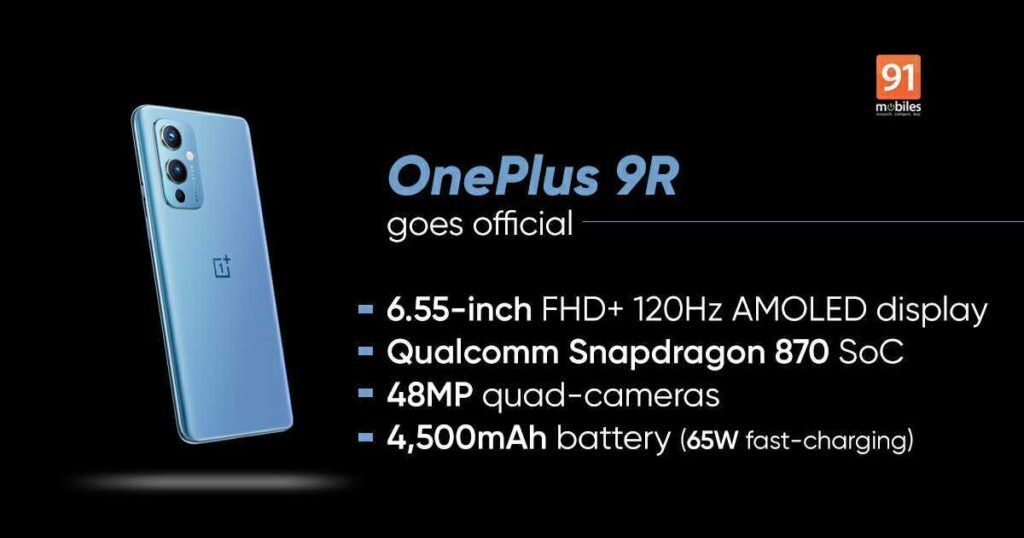
Lastly, we get to what is undoubtedly one of the most high-profile launches of March 2021, the OnePlus 9 series. Both OnePlus 9 phones are largely the same this time around, with the display and camera being the primary differentiation factors, along with wireless charging support. Both phones are powered by a 4,500mAh battery that supports 65W fast charging. A Qualcomm Snapdragon 888 chipset coupled with up to 12GB of RAM and 256GB of storage lies at the heart of both devices. The OnePlus 9 Pro has the added benefit of 50W wireless charging via compatible hardware.
OnePlus 9 Pro
The OnePlus 9 Pro runs a 6.7-inch QHD+ LTPO AMOLED panel with a 120Hz refresh rate. It is HDR10+ certified and comes with a layer of 3D Corning Gorilla Glass layer and punch-hole cutout. It is powered by the Snapdragon 888 5G SoC coupled up to 12GB LPDDR5 RAM and 256GB UFS 3.1 storage. At the back, we get a Hasselblad-branded quad-camera array consisting of a 48MP Sony IMX789 primary sensor, a 50MP ultra-wide-angle Sony IMX766 sensor, an 8MP telephoto lens with f/2.4 aperture, and a 2MP monochrome sensor. There is a 16MP Sony IMX471 camera on the front with EIS and f/2.4 aperture for selfies and video chats.
OnePlus 9
The base OnePlus 9 has a slightly smaller 6.55-inch FHD+ AMOLED panel with a 120Hz refresh rate. HDR10+ support is included, too. At the back, we get a 48MP Sony IMX689 sensor, a 50MP Sony IMX766 ultra-wide-angle lens, and a 2MP monochrome lens. Everything else is identical to that of the OnePlus 9 Pro, including the selfie camera, battery capacity, and internal hardware.
OnePlus 9R
OnePlus surprised everyone by launching an India-only smartphone called the OnePlus 9R. It is essentially a OnePlus 8T with a fresh coat of paint, as it reuses the same 6.55-inch FHD+ AMOLED display with a 120Hz refresh rate. The Qualcomm Snapdragon 870 SoC is essentially a slightly overclocked Snapdragon 865+. It can be paired with up to 12GB LPDDR5 RAM and 256GB UFS 3.1 internal storage.
The OnePlus 9R’s quad-camera array is reminiscent of its predecessor too, as it features a 48MP Sony IMX586 sensor, a 16MP Sony IMX481 ultra-wide-angle lens, a 5MP macro lens, and a 5MP monochrome sensor. There is a 16MP snapper on the front for selfies and video chats, an in-display fingerprint sensor for security. Its 4,500mAh supports 65W fast wired charging.
The post Smartphones launched in India in March 2021: Redmi Note 10, OnePlus 9, Realme 8, and more first appeared on 91mobiles.com.
via ©91 Mobiles









ليست هناك تعليقات:
إرسال تعليق